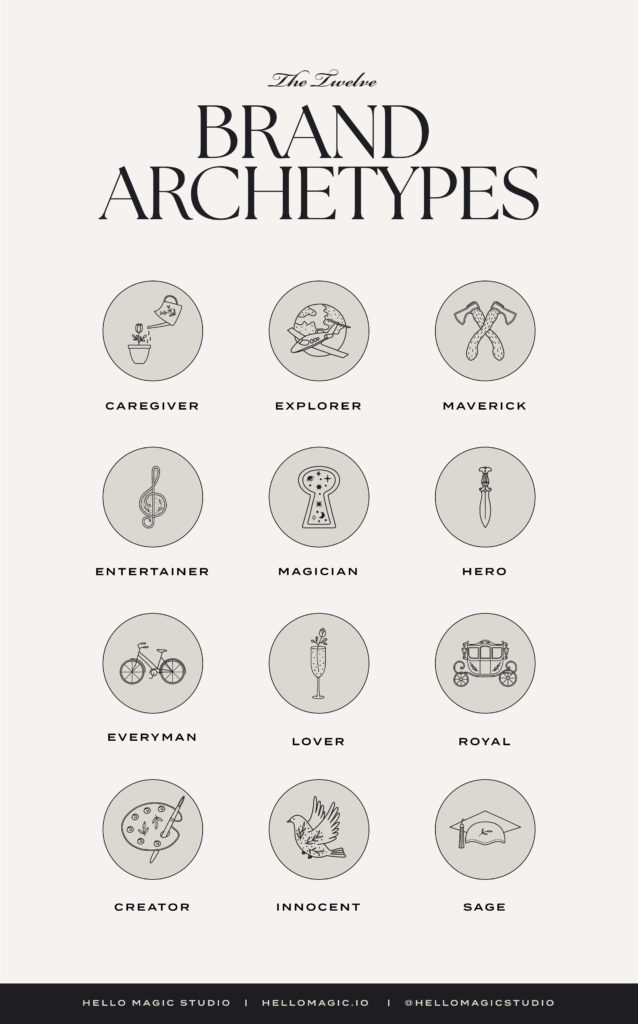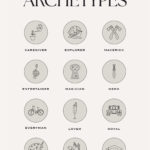It can be difficult for customers to gauge your brand’s true intentions when each brand strives to be unique. Using brand archetypes is a simple way to make it easier to decipher a brand’s motivations.
There are twelve different archetypes your brand can fit into. This article will give you the insight to help you figure out what type of brand you are and how your target audience perceives you.
The Caregiver
The Caregiver brand archetype represents brands that prioritize the well-being and care of others. These brands often position themselves as providers of support and assistance, and they often prioritize altruism and compassion in their messaging and branding. Caregiver brands often seek to create a sense of security and comfort for their customers, and they may also emphasize their reliability and trustworthiness. Caregiver brands often strive to create a sense of community and belonging, and they may also emphasize their commitment to social responsibility and making a positive impact on the world.
Caregivers go beyond good deeds and basic kindness. Caregiver brands live to take care of others. They are more parental than the other archetypes and take great pride in focusing on the customer’s needs. Showcasing reality, Caregivers don’t shy away from life’s real-world problems. Instead, they offer support and remain empathetic and selfless in light of everyday issues. Caregiver archetypes tend to have a charitable brand voice that’s more on the nurturing side, and they produce content that stands in support of good causes.
Example Caregiver Brands:

The Creator
The Creator brand archetype represents brands that prioritize innovation, self-expression, and the creation of new ideas and products. These brands often position themselves as sources of inspiration and as trailblazers in their industries, and they may emphasize their uniqueness and originality in their messaging and branding. Creator brands often seek to empower their customers to express themselves and explore their creativity, and they may also emphasize their commitment to helping their customers achieve their goals and dreams.
Creator brands often seek to inspire and motivate their customers, and they may also emphasize their willingness to take risks and challenge the status quo.
Creators thrive off of a free flow of creativity and imagination, though they stay well within their control. They’re all about mastering their craft and having the freedom to make whatever art they’d like. Needless to say, Creators hate mediocrity and cheap knock-offs! Bringing new ideas into the world, Creators are dreamy and ambitious. Their brand voice is imaginative and sometimes a little unconventional, but their content encourages self-expression and innovation.
Example Creator Brands:

The Entertainer
If your brand feels like the life of the party, it may be an Entertainer! Entertainers are light-hearted and playful. This means they don’t take life too seriously, and they’re ready to make people laugh.
The Entertainer brand archetype represents brands that prioritize fun, entertainment, and the celebration of life. These brands often position themselves as sources of joy and enjoyment, and they may emphasize their playfulness and sense of humour in their messaging and branding. Entertainer brands often seek to create a sense of excitement and energy for their customers, and they may also emphasize their ability to bring people together and facilitate social connections. These brands often strive to create a sense of escape and relaxation for their customers, and they may also emphasize their commitment to providing high-quality and memorable experiences.
An Entertainer’s brand voice is enthusiastic and expressive, while their content makes their audience giddy and quite energetic. While it can be self-deprecating at times, entertainers draw the line at boredom, whether it’s themselves or the audience feeling it.
Example Entertainer Brands:

The Explorer
The Explorer brand archetype represents brands that prioritize adventure, discovery, and the pursuit of new experiences. These brands often position themselves as guides and facilitators of exploration and growth, and they may emphasize their sense of curiosity and desire for knowledge in their messaging and branding. Explorer brands often seek to inspire their customers to push the boundaries of their comfort zones and to try new things, and they may also emphasize their commitment to helping their customers achieve their full potential.
Examples of Explorer brands might include travel companies, outdoor equipment manufacturers, and other organizations that facilitate exploration and adventure. These brands often strive to create a sense of excitement and wonder for their customers, and they may also emphasize their ability to connect people with the world around them.
Explorer brands have an adventurous spirit and an affinity with the outdoors. They appreciate the journey and love to seek out new things, especially if it means helping others experience more fulfilment. Their to-do list involves being true to themselves and renouncing conformity. Authenticity and individuality are what fuel them. An Explorer’s brand voice is open-minded and very tolerant. Their content is warm, and trusting, and gives their audience a space to feel understood.
Example Explorer Brands:

The Everyman
The Everyman (also called the “Guy/Girl Next Door”) may be hardworking, but they’re also very humble and down-to-earth. They wish to find acceptance and a place of belonging and they don’t like to be left out. The Everyman brand archetype represents brands that prioritize accessibility, simplicity, and the needs and concerns of ordinary people. These brands often position themselves as reliable and trustworthy sources of everyday products and services, and they may emphasize their down-to-earth, no-nonsense approach in their messaging and branding.
Everyman brands often seek to create a sense of familiarity and comfort for their customers, and they may also emphasize their commitment to providing high-quality products at affordable prices. Examples of Everyman brands might include grocery stores, pharmacies, and other retailers that provide essential products and services to the general public. These brands often strive to create a sense of reliability and trustworthiness for their customers, and they may also emphasize their commitment to honesty and transparency.
Their brand voice is always honest, practical, and friendly, with content that tells their audience they’re understood. It’s warm, trusting, and encouraging. If you’re the Guy/Girl Next Door type, then you’re reliable and able to create genuine friendships with your audience.
Example Everyman Brands:

The Hero
The Hero brand archetype represents brands that prioritize strength, courage, and the protection of others. These brands often position themselves as champions and protectors, and they may emphasize their power, determination, and sense of purpose in their messaging and branding. Hero brands often seek to inspire their customers to be their best selves and to overcome challenges, and they may also emphasize their commitment to helping their customers achieve their goals and dreams. Examples of Hero brands might include fitness companies, sports teams, and other organizations that encourage personal growth and achievement. These brands often strive to create a sense of pride and accomplishment for their customers, and they may also emphasize their ability to bring people together and create a sense of community.
Hero brands are meant to be inspiring, strong, and competent. They show the audience that courage and determination get the job done, even in the face of weakness and vulnerability. This may come across as aggressive, or even arrogant, but the Hero always prevails in the end. A Hero brand voice will be motivational and direct. Their content leaves their audience feeling empowered and feeling inspired, like a hero themselves.
Example Hero Brands:

The Innocent
The Innocent brand archetype represents brands that prioritize purity, simplicity and a sense of childhood wonder. These brands often position themselves as sources of goodness and joy, and they may emphasize their innocence, sincerity, and sense of wonder in their messaging and branding. Innocent brands often seek to create a sense of nostalgia and happiness for their customers, and they may also emphasize their commitment to honesty, simplicity, and transparency.
Examples of Innocent brands might include children’s toys and clothing, food and beverage products, and other organizations that evoke feelings of childhood innocence and wonder. These brands often strive to create a sense of happiness and positivity for their customers, and they may also emphasize their commitment to making the world a better place.
Valuing simplicity and the joys of life, the Innocent archetype looks for wholesome interactions and a sense of nostalgia. An Innocent brand voice is lighthearted, modest, and wholesome. Their platform is built on honesty and optimism while renouncing negativity and cynicism. The Innocent content offers solutions to common problems and aims to make life simply enjoyable.
Example Innocent Brands:

The Lover
The Lover brand archetype represents brands that prioritize passion, intimacy, and emotional connection. These brands often position themselves as sources of connection, romance, and sensuality, and they may emphasize their ability to facilitate emotional and physical connections in their messaging and branding. Lover brands often seek to create a sense of intimacy and emotional depth for their customers, and they may also emphasize their commitment to quality, craftsmanship, and attention to detail.
Examples of Lover brands might include luxury goods, fashion and beauty products, and other companies that facilitate personal and interpersonal connections. These brands often strive to create a sense of indulgence and pleasure for their customers, and they may also emphasize their ability to create meaningful and lasting experiences.
Feeling beautiful and stirring up feelings of bliss is the end goal of the Lover archetype. They relish in the joys of intimacy, sensuality and pleasure. Lovers don’t like jealousy or indifference, but they can’t help but dote on the ones they care about the most. Their brand voice is indulgent, passionate, and alluring, while their content centres around their audience’s desirability.
Example Lover Brands:

The Magician
The Magician brand archetype represents brands that prioritize transformation, mystery and the power of imagination. These brands often position themselves as sources of inspiration and as facilitators of change, and they may emphasize their ability to create something from nothing in their messaging and branding. Magician brands often seek to inspire their customers to think outside the box and to see the world in new and exciting ways, and they may also emphasize their commitment to innovation and creativity.
Examples of Magician brands might include technology companies, advertising agencies, and other organizations that facilitate transformation and change. These brands often strive to create a sense of wonder and possibility for their customers, and they may also emphasize their ability to help people achieve their goals and realize their dreams.
If a brand is charismatic, it may fall under the Magician archetype. They manifest change and seem to solve even the most unsolvable problems. Magicians are wise and holistic and encourage self-improvement. Magician brands strive to transform lives and expand minds. They commonly have a spiritual or psychological aspect, and position themselves as a bearer of knowledge, whether ancient or new. Magician brands use a tone of voice that is often ethereal, inspiring, and thought-provoking. Their content is an eclectic blend of science and spirituality.
Example Magician Brands:

The Maverick
The Maverick brand archetype represents brands that prioritize independence, nonconformity, and the challenge of the status quo. These brands often position themselves as rebels and outsiders, and they may emphasize their willingness to take risks and challenge authority in their messaging and branding. Maverick brands often seek to inspire their customers to think for themselves and to resist the pressures of conformity, and they may also emphasize their commitment to authenticity and individuality. These brands often strive to create a sense of excitement and rebelliousness for their customers, and they may also emphasize their commitment to making a positive impact on the world.
Maverick (also called “Outlaw”) brands are industry disruptors, status-quo breakers, fiercely reinventive and totally unapologetic about it. They are bold, and may even use curse words, comedy or other unexpected language to shake things up. They are looking to break the mould with new ideas, and this wins them some fanatics and some haters. A Maverick brand voice is raw and honest, with content that inspires the audience to tap into their rebellious and impulsive sides. They aren’t afraid to tell the truth and make some noise.
Example Maverick Brands:

The Royal
The Royal brand archetype represents brands that prioritize luxury, exclusivity, and the highest quality. These brands often position themselves as symbols of prestige and success, and they may emphasize their ability to provide the very best in their messaging and branding. Royal brands often seek to create a sense of grandeur and opulence for their customers, and they may also emphasize their commitment to craftsmanship, attention to detail, and exclusivity.
Examples of Royal brands might include high-end fashion and jewellery brands, luxury hotels and resorts, and other companies that offer the highest level of quality and exclusivity. These brands often strive to create a sense of refinement and sophistication for their customers, and they may also emphasize their ability to provide exceptional and memorable experiences.
Royal brands are luxurious to their core. They offer something truly elite and exclusive that not just anyone can get their hands on. They inspire their audience to strive for the best and enjoy the beautiful things in life. They aren’t driven by fluctuations in trends, popularity or making a quick buck. Instead of appealing to the masses, they set themselves apart as an aspirational brand that invites people to be part of an exclusive club.
Royal brands are influential, wealthy and powerful. They seek to dominate and cater to an audience with a sense of superiority. They often come across as classic, noble, proper and timeless. A Royal’s tone is sophisticated and refined. Their content is elegant and showcases their higher status, while also encouraging their audience to indulge in their elitism.
Example Royal Brands:

The Sage
The Sage brand archetype represents brands that prioritize wisdom, knowledge and the pursuit of understanding. These brands often position themselves as sources of information and guidance, and they may emphasize their intelligence, expertise, and thoughtfulness in their messaging and branding. Sage brands often seek to create a sense of trust and reliability for their customers, and they may also emphasize their commitment to providing accurate and useful information. Examples of Sage brands might include educational institutions, libraries, and other organizations that facilitate the pursuit of knowledge and understanding. These brands often strive to create a sense of intelligence and depth for their customers, and they may also emphasize their ability to help people make informed and intelligent decisions.
Pursuing the truth may seem like a full-time job, but to the Sage archetype, it’s a lifestyle. Sages avoid misinformation and raise awareness. These experts guide consumers towards the right decisions and aim to enlighten them in such a deceptive reality. The Sage brand voice is scholarly, analytical, and deep. Their content is heavily researched and stimulating. You won’t find any ambiguity or ignorance on their platforms!
Example Sage Brands:

Where Does Your Brand Fit In?
Out of twelve different archetypes, do you know where your brand fits in?
You may find yourself leaning into two different categories but don’t get discouraged. Look at what brand voice and content you strive to create, and that should give you an archetype to reach for. Keep in mind that a great brand is one that remains consistent and gives its audience a sense of reliability.
In an ever-changing world, don’t try to be just like everyone else. Even when you’re following a structure or settling with a brand archetype, your business is still just as unique as your fingerprints!

At Hello Magic, we are in love with Showit. We’re all about building beautiful websites that attract your dream customers and the only thing better than a gorgeous online home is a gorgeous online home that converts. To get the best of both worlds, you need to know how to optimise your Showit site for SEO.

Excellent photography is one of the key ingredients in a show-stopping, stand-out-from-the-crowd kind of website. Here are our top tips for planning a brand photoshoot that will produce website-worthy images.

“Should I use Showit or Squarespace for my website?” This is a question we hear from many clients. And no wonder. Figuring out whether you should create a website using Squarespace or Showit is like trying to find a consensus over whether pineapple belongs on pizza or not.

Are you considering investing in professional branding or a rebranding project but unsure if it’s even worth it? It’s a valid concern. After all, there are many factors to take into account when making such an important decision for your business. To help you out, we’ll share with you a few cold, hard stats about the benefits of branding that just might convince you to take the plunge.

Template or custom: which is right for you? In this post, we compare all the differences between a custom Showit design and a Showit premade template to figure out which option is best for you and your business.

At Hello Magic, we are in love with Showit. We’re all about building beautiful websites that attract your dream customers and the only thing better than a gorgeous online home is a gorgeous online home that converts. To get the best of both worlds, you need to know how to optimise your Showit site for SEO.

Are you considering investing in professional branding or a rebranding project but unsure if it’s even worth it? It’s a valid concern. After all, there are many factors to take into account when making such an important decision for your business. To help you out, we’ll share with you a few cold, hard stats about the benefits of branding that just might convince you to take the plunge.


